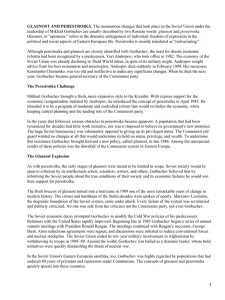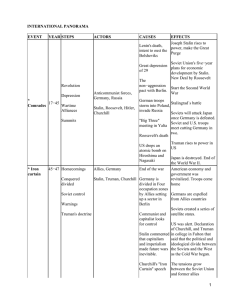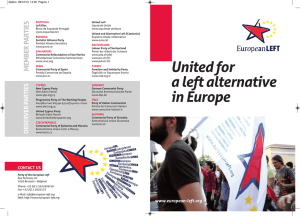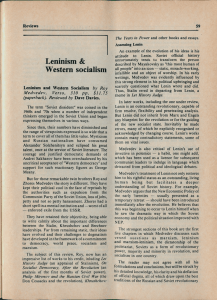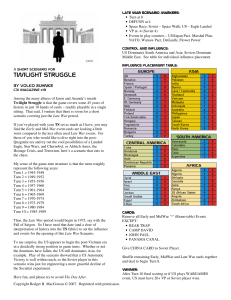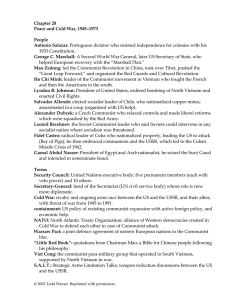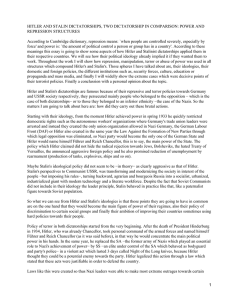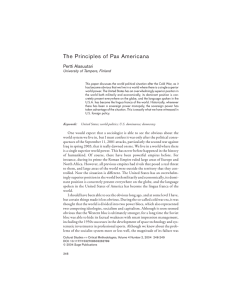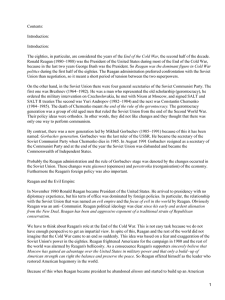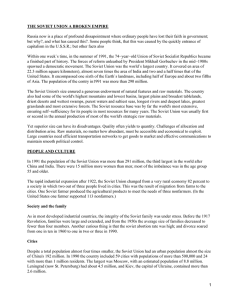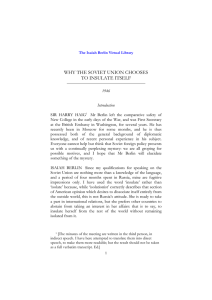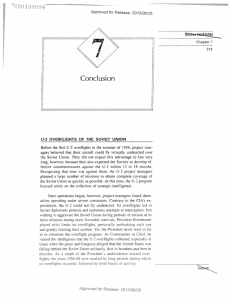Cold War # Guerra Fría
Anuncio
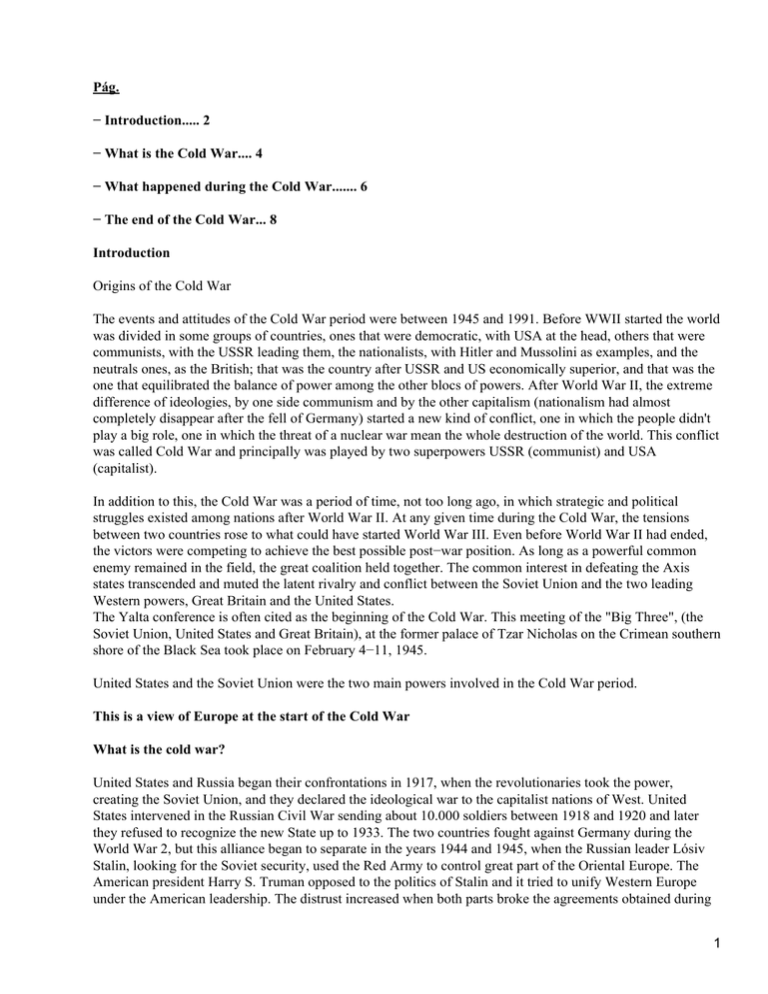
Pág. − Introduction..... 2 − What is the Cold War.... 4 − What happened during the Cold War....... 6 − The end of the Cold War... 8 Introduction Origins of the Cold War The events and attitudes of the Cold War period were between 1945 and 1991. Before WWII started the world was divided in some groups of countries, ones that were democratic, with USA at the head, others that were communists, with the USSR leading them, the nationalists, with Hitler and Mussolini as examples, and the neutrals ones, as the British; that was the country after USSR and US economically superior, and that was the one that equilibrated the balance of power among the other blocs of powers. After World War II, the extreme difference of ideologies, by one side communism and by the other capitalism (nationalism had almost completely disappear after the fell of Germany) started a new kind of conflict, one in which the people didn't play a big role, one in which the threat of a nuclear war mean the whole destruction of the world. This conflict was called Cold War and principally was played by two superpowers USSR (communist) and USA (capitalist). In addition to this, the Cold War was a period of time, not too long ago, in which strategic and political struggles existed among nations after World War II. At any given time during the Cold War, the tensions between two countries rose to what could have started World War III. Even before World War II had ended, the victors were competing to achieve the best possible post−war position. As long as a powerful common enemy remained in the field, the great coalition held together. The common interest in defeating the Axis states transcended and muted the latent rivalry and conflict between the Soviet Union and the two leading Western powers, Great Britain and the United States. The Yalta conference is often cited as the beginning of the Cold War. This meeting of the "Big Three", (the Soviet Union, United States and Great Britain), at the former palace of Tzar Nicholas on the Crimean southern shore of the Black Sea took place on February 4−11, 1945. United States and the Soviet Union were the two main powers involved in the Cold War period. This is a view of Europe at the start of the Cold War What is the cold war? United States and Russia began their confrontations in 1917, when the revolutionaries took the power, creating the Soviet Union, and they declared the ideological war to the capitalist nations of West. United States intervened in the Russian Civil War sending about 10.000 soldiers between 1918 and 1920 and later they refused to recognize the new State up to 1933. The two countries fought against Germany during the World War 2, but this alliance began to separate in the years 1944 and 1945, when the Russian leader Lósiv Stalin, looking for the Soviet security, used the Red Army to control great part of the Oriental Europe. The American president Harry S. Truman opposed to the politics of Stalin and it tried to unify Western Europe under the American leadership. The distrust increased when both parts broke the agreements obtained during 1 the World War. Stalin didn't respect the commitment of carrying out free elections in Oriental Europe. Truman refused to respect its promises of shipment of compensations to help to the reconstruction of the Soviet Union, desolated by the war. The American officials, worried by the Soviet pressure in Iran and Turkey, interpreted a speech of 1946 carried out by Stalin like the declaration from the ideological war to West. In 1947 the president proposed a project that had two objectives: to send American help to the anticommunist forces of Greece and Turkey, and to create a public consent for which the Americans would be willing to combat if there were to be a conflict. It reached both objectives. That same year, journalist Walter Lippmann popularized with his book the concept of Cold War which is the name of how we recognize this conflict nowadays. In the American Congress there was an intensive interrogation to all those who were thought to be pro−communists in United States. The better known investigator, Senator Joseph Raymond McCarthy, gave name to an era of intense anti−communisms. In 1948 the United States threw the Marshall plan (Program of European Recovery) that gave 13.000 million dollars to reconstruct Central and Western Europe. When Stalin responded increasing its control Oriental Europe it has more than enough and threatening the position of West in Germany, Truman helped to create a military alliance. It was: the Organization of the Treaty of the North Atlantic (NATO), and to establish an independent Western Germany. The cold War increased in the years 1949 and 1950, when the Soviets carried out its first explosion of an atomic bomb and the communists from China conquered the whole country. These signed an alliance with Stalin, but United States refused to recognize to the new regime. In Japan, the low American control, accelerated the economic development to fight against the Asian communism. When the communists of North Korea invaded South Korea in 1950, Truman sent to the American army to the action. The conflict, well−known as war of Korea, it concluded three years later with a pact that they would leave the frontier established previous to the war. In 1953 Stalin died and Truman abandoned its position, but both parts followed its fight for Europe. The USSR tried to protect the communist Oriental Germany of an important population loss by building the Berlin Wall. Each superpower also tried to influence in the developing nations of Asia, Africa, Next East and Latin America. In South America, the Caribbean and in Central America as much the rebellious movements as the permanent coups were often, framed in this conflict. The Doctrine of the National Security that arose in the decade of 1960 influenced in all South America, producing permanent violations of the human rights. In 1962 a serious crisis arose when the USSR installed missiles in Cuba, Its new ally in those years. President John Fitzgerald Kennedy threatened nuclear reprisals and the Soviets retired the missiles in exchange for the promise that they would not invade Cuba. The crisis of the missiles produced disputes in the American Organization of States (OAS). Once the crisis calmed, the Soviets also weakened when the Chinese leaders separated Moscow and the Europeans of the East began to show their disagreement. The nationalism demonstrated to be stronger than the communism. Meanwhile, United States was fighting in the war of Vietnam, bloody military action in a bankrupt effort to conserve Vietnam of the South. Also, the economic superiority of post−war period of United States was challenged by Japan and Western Germany (Federal Republic of Germany). Toward 1973 the two superpowers agreed a distension politics. It was intent of stopping the expensive arms career and broke their political, military and economic competition in the Third World. However, the distension lasted up to 1980, when Soviet troops invaded Afghanistan to save the ruling Marxist regime. The recently elected American president Ronald Reagan began a great concentration of weapons and new challenges for the groups supported by the Soviets in the emergent nations. These are some photos of before and after What happened? Everything started when the civil servants from the United States, that were very worried of the pressure that the Sovietics had in Iran and Turkey, interpretated one speech that Stalin made as an ideological declaration of 2 war to the Occident. In 1946 the Prsident purposed the Truman Doctrine that had two main objectives: 1) To help the anticommunist forces of Greece and Turkey. 2) To create States. In 1948 the United States made the Marshall Plan (European recuperation program) which consisted of a 13000 milion dollars that were used to reconstruct Central Europe and Occident. They did that because the economic situation in Europe was very bad and the States needed us to be well economically speaking as we were their best clients and if we didn't had money we could not buy them any products. Stalin answered this American action by increasing it's control over the Oriental Europe and threatened the Occidental position in Germany, then Truman created one military alliance, the North Atlantic Treaty Organisation (OTAN), and established one Occidental Independent Germany. The Cold War increased during 1949 and 1950 when the Sovietics made their first explosion of an atomic war and the chinese communists conquered all the country. The Chinese communists signed an alliance with Stalin, but the United States didn't want to recognise this new alliance. In Japan, which were under the control of the United States, accelerated their economic development to fight against the Asiatic communism. When North Korea, which was Communist, invaded South Korea a public consensus by which the American forces would be prepared to fight in a supposed conflict. The United States reached both objectives. In the same year a journalist named Walter Lippmann called this war the Cold War thanks to a book he wrote. In the American congress there were lots of interrogatories in which they made a lot of publicity of the pro−communist activities that were taking part in the United in 1950, Truman made the American army enter into action. The conflict, known as the Korean War, concluded three years after with the tregua that left the frontiers as they were before the agreement. In 1953 Stalin died and Truman left his place, but both (the Americans and the Sovietics) continued their fight for Europe. The URSS tried to protect to the Occidental Communist Germany from the increasing lost of population that this part of Germany was having by creating the Berlin Wall in 1961. Both powers also tried to influence in the new nations that were appearing in Asia, Africa Latin America and the East. In South America, the Caribbean and Central America the Coups d `Etat that were happening, were in the same marc than the Cold War. The National Security Doctrine that took part in the 1960's influenced all South America, producing permanent violations of the human rights. In 1962 a serious crisis when the URSS installed their missiles in Cuba, which was their new allied. The American President John Fitzgerald Kennedy threatened with nuclear weapons and the Sovietics said that they would retire their missiles if they promised that they would not invade Cuba. The crisis of the missiles produced some problems in the American States Organization. While the Sovietics were calmed because of the missiles crisis they're problems also started as the Chinese separated from them and the European zones that were very influenced by them started to show their unhappiness. The Nationalistic ideas started to be stronger than the Communist ideas. Meanwhile the United States continued fighting in the Vietnam War as they wanted to preserve the South of Vietnam but they failed. The post−war economical superiority was retada by Japan and Occidental Germany (Federal Republic of Germany). In 1973 both countries, which were confronted, agreed to make a politic policy based on the distance. This was a way of avoiding the expensive armamentistic career and to stop the political competition and economic in the third world. But this policy lasted until 1980 when the sovietic troops invaded Afghanistan to save the Marxist regime. The new American President Ronald Reagan started a great weapon concentration and new retos for the groups that were supported by the sovietics in the new countries that were appearing. So I would describe this war as a war were both sides wanted to show and impose their power but without creating another real war ,it could be described as a pacific war. 3 This is an Automatic Machinegun used in the Korean War. The End of the Cold War The demise of the Soviet Union began when Mikhail Gorbachev came to power as its General Secretary in 1985. Understanding the bad state of the Soviet economic and financial affairs, he brought a message of reform and change. He announced two new policies− glasnost and perestroika−which he thought would save the communist system. However, these new policies would ultimately overturn the Soviet system. Glasnost Glasnost did away with the strict censorship, which the government had practiced for decades. Russian for "openness," glasnost allowed Soviet citizens to speak openly about their society's problems. Banned books were made available, and jamming of foreign radio broadcasts was stopped. Perestroika Glasnost was only the first step. Next came perestroika, Russian for "restructuring." Perestroika was not an attempt by Gorbachev to destroy communism, but an attempt to end the inefficiency and corruption that were so common. Some features of private enterprise returned under perestroika. Product prices would rise when production costs rose. Local factories had more power of their decisions as planning was decentralized. Finally, multicandidate elections would be held, although each candidate had to be a member of the communist party. Poland Poland's Solidarity labour union began to rise in power in the late 1970's. They organized strikes, demanding more pay and changes to the unfair labour practices. They organized strikes, demanding more pay and changes to the unfair labour practices. Eventually, they won an end to censorship and political repression, religious freedom, and recognition as a labour union. Gorbachev watched Solidarity's strikes crushed the Polish economy, and finally forced the Polish leaders to allow free elections. The Solidarity candidates were only allowed to run for a third of the seats, but swept the elections in which they ran. Still a communist government, the nation faced massive economic hardships. As electricity, gas, and water prices rose 500 percent while wages remained frozen, the Communist Party voted to dissolve itself on January 29, 1990. Poland changed its name from the People's Republic of Poland back to its pre−World War II name, the Republic of Poland. Democratic elections were held, and communism fell. Berlin Wall The Berlin Wall was built by the Soviets to prevent citizens of East Germany from escaping to West Germany. East Germany, while prospering compared to its Marxist−Leninist neighbours, was an embarrassment compared to West Germany. East Germans made only one−third of the wages of West German workers, and often had to endure goods shortages. If it were not for the Berlin Wall, hundreds of thousands of Germans might have fled to the West. These are some photos of before and after East Germans could not escape to the West via West Germany. However, in 1989 nearby Hungary opened its border to noncommunist Austria and East Germans swarmed through Czechoslovakia to Hungary , and then escaped to the West. Within a year, 500,000− East Germans had left their homeland. In order to prevent any further escapes, East Germany closed its border with Czechoslovakia in early October, 4 but could not keep the lid on things much longer. When Gorbachev visited East Germany to commemorate the fortieth anniversary of East Germany, large crowds begged him for help. Large crowds and protests grew, and when he could not keep control any longer, the East German Communist Party general secretary Eric Honecker resigned. His replacement, Egon Krenz, met with the protesters and listened to their problems. Soon after, he fired his entire cabinet and ordered the Berlin Wall opened. The wall was opened on November 9, 1989. Huge crowds surged from the east. Guards on the West Berlin side, at Checkpoint Charlie, did not know what to do and they refused at first to let the freedom seekers in. Finally, it was allowed to open the gate. Angelike Wache, was the first person to pas across. The communist regime crumbled rapidly. On March 18, 1990, East Germans voted the communists out of office, and in September East Germany became the first member to leave the Warsaw Pact. All of the Soviet troops were withdrawn from East Germany by the end of 1994. 2 History Project The Cold War April 2002 5
